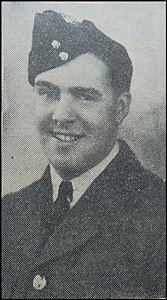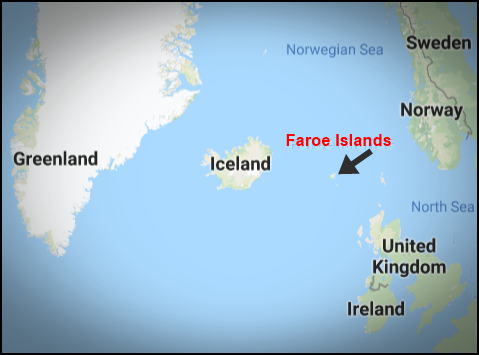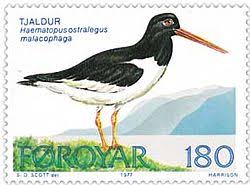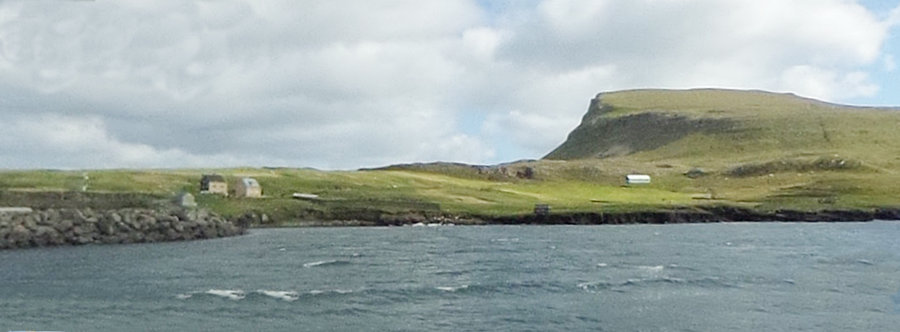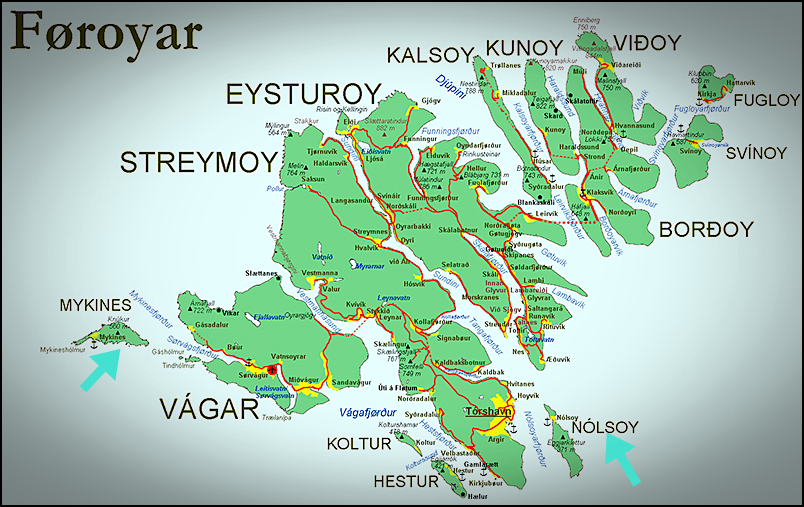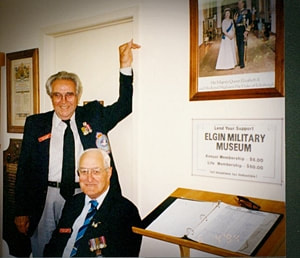Nolsoy in the Faroe Islands
Windy War
Earl Moore of St. Thomas, Ontario did not have a typical wartime experience in the Royal Canadian Air Force. Part of the group of men chosen to work with the emerging technology known today as radar, Earl and his colleagues faced many challenges. While fellow St. Thomas native Stuart Paddon had the benefit of knowing about his radar sets but nothing about the ships on which he served, Moore had the opposite problem, neither he nor any member of his team had ever seen most of the equipment he had to use. In the process of making them work, they invented the 'Radar Dome'.
|
Where?
Diaries Sometimes tell Porkies
|
My diary for November 10/11 of 1942 said “A little rough and later a little sick”. It should have been “very, very rough and suddenly very sick – the sickness soon passed, the rough sea didn’t”. We had sailed from Aberdeen at 5:45 pm on November 10th. There were 300 assorted troops crammed into a 1600 ton ship named the Tjaldur, supposedly named after the national bird of the Faroes, and we were no sooner beyond the anti-submarine nets, then the weather hit. In the 40 plus hour, 400 to 500 mile trip we lost a carley float and our barrage balloon, otherwise the voyage seemed uneventful.
|
Nobody Mentioned we needed to be Commandos
In any case our 14 man Radio Direction Finding (Radar) crew had arrived and after a quick weapons course, and working at odd jobs, we were moved to Nolsoe Island guarding the East side of the Island and Torshavn. We hadn’t been trained as Commandos, but we managed a 20 to 30 foot cliff straight up from a bouncing small boat. It had been too rough to land at the little dock at the point of the Island. We struggled, with our kit, up another very steep 400 feet to the light keepers’ row of houses which were our living quarters. I moved on up another stiff climb to what I assumed was the Radar station.
Never make Assumptions such as Previous Training Applicable
My assumption was made on the basis of a Yagi array sticking from the top of a small hut surrounded by an earth, bomb-blast wall. It is perhaps of some interest that none of the personnel of our crew had ever worked on Air to Surface Vessel or similar types of equipment. We were all from Chain Home (CH) stations, and at least, in most cases, had never seen an ASV set. True the principles were the same, but the rest we learned from secret documents or by trial and error. It was an interesting experience.
Strategic Spot
The Faroes lie in a very strategic spot in the North Atlantic. If held by the Germans, they could have done much more damage to the North Atlantic and Murmansk convoys than they did. The Faroe Island Force consisted of Naval, Army and Air Force elements. The Radar installations were located at five sites. Mykines and Sandoy covered the West, Eide the North, Sudoroy the South and Nolsoe the East, including the approaches to Torshavn the Capital. There was a control plotting room, at Torshavn manned by Naval and Air Force personnel and links to the Ack-Ack Units. As I indicated, we never had a fighter capability and therefore our primary job was Early Warning for aircraft, plotting of shipping and tracking our patrols. We frequently plotted enemy aircraft, from milk run “Weather Willies” (stripped down JU88’s) to armed and lethal JU88’s which would drop the odd bomb or strafe a target of some type.
Primitive Equipment
The Radar at four of the five stations was ASV converted to ground use. It was installed in a tent to provide darkened conditions inside a wooden shed. The aerial was a single Yagi which was mounted on the top of a shaft which in turn passes through an automobile steering wheel which was the turning gear. The coaxial cable passed through the roof and was given a couple of loops to allow the aerial to swing 360 degrees. The wise crew installed a stop to prevent a continuous turning from snapping the cable. I can’t remember the exact dipole length, but it was approximately one meter across the reflector, or 60 cm for the one half dipole. It was indeed primitive equipment, but we would (from our high cliff) cover shipping 20 to 25 miles and aircraft from 75 to 90 miles. The fifth station at Ride on the extreme north of the Island was a 271 high frequency, Naval type set. It had a very narrow beam and perched on a 1200 foot cliff could plot shipping at very long range and with great accuracy.
Parts Falling Off
We had plenty of problems from technical to supply and not least, the weather. Our power supply was a J.A.P. Generator, a little work horse but worked to extreme, and we were short of spares. The electronic equipment gave its share of problems. The transmitter valves (tubes) VT90s for instance, had cooling rings which were frequently simply falling off. Getting a new supply was often impossible, and trying to repair just as impossible. However, most of the time we remained serviceable and did our job.
Could be Blown to Norway
Well if weather didn’t start in the Faroes, it certainly was there in spades. Very frequently from October to May, and fairly often in the other months we would be forced to lash the aerials because of wind. I am talking of gale and storm and hurricane force winds, winds in which it took three men to do the job, one to tie the ropes and two to hold that man so he could work. All of this on a roof 20 or 30 feet from a 400 foot drop to the sea. Actually we often joked that we wouldn’t hit the sea, but would end up in Norway.
New Light Warning Radar
We had been told that a new type of Light Warning Radar was coming. I had gone on leave, and when I returned in early August the new gear had arrived. For the second time I was faced with a Radar type I had never seen, and I was placed in charge of putting it together. We had a crew and using the Secret Documents, we assembled the set in a hanger. In comparison to the old ASV converted, we had a very sophisticated piece of Radar-gear. It was more powerful; it had a sweep scan of P.P.I. The aerial was a stacked Yagi which gave us a height finding capability. It was also a full continuous sweep aerial working through a slip ring mechanism. The power supply was a 2 cylinder Douglas Generator, a much superior motor compared to our old JAP’s. so, we had several new Early-Warning (portable) Radar sets and there had been a plan to replace the old units. What do we do? The officer commanding signals at that time was a Fl/Lt Pond. He was not Radar but was interested and felt we should get on with installations. I agreed; but, I wanted to try the set out of the hanger.
Equipment Assembled Now What About the Wind
Even in summer the wind can be a problem and we began to think about ways we might deal with it. I think it was Fl/Lt. Pond who asked if we could use some type of shield against wind. The Radar types didn’t know but we had been able to get some ground responses from outside the hanger and felt something might work. Someone finally suggested plexiglass and the idea developed from there. The Radar was set up in its tent and we decided to build a support frame around the tent with a platform on which we could erect the dome or wind-screen. The support frame was formed from metal scaffolding and was a fairly solid affair. On the scaffold we built a platform of plywood. This platform was at a level where the aerial mast came out of the tent. We were fortunate, as for some reason there were large sheets of plexiglass in the stores at Vagar. We assumed they were there for aircraft repairs, but in any case we were able to requisition and obtain these. We built a wooden frame to hold the plexiglass and with much effort soon had a completely encircled, stacked Yagi aerial.
Mission Accomplished
My diary of Tuesday, August 17/43 states “worked down the lake on dome or wind shield for aerials. August 18/43 Got wind screen up and gear going as good as ever”. So we appeared to have succeeded. Now it was a matter of comparison of results. It is interesting to note the aerials were now protected but we as crew were living in tents, cooking in the open and even sleeping in the boxes in which the gear was packed. We did 48 hour shifts and then had a day in base camp. On August the 24th, we set a record distance plot of 86 miles. All I remember is it was a Sunderland, and they did give a good response, but it did prove you could send a Radar beam through plexiglass. The next day we had another pick up at 89 miles, and on August 25th we hit 100 miles. My comment was “damn fine gear”. The station at Vagar continued to operate through August and into September. We had plenty of opportunity to check that the dome actually worked in the wind. We never shut down because of wind even though on one occasion we lost a tent blown over the cliff.
